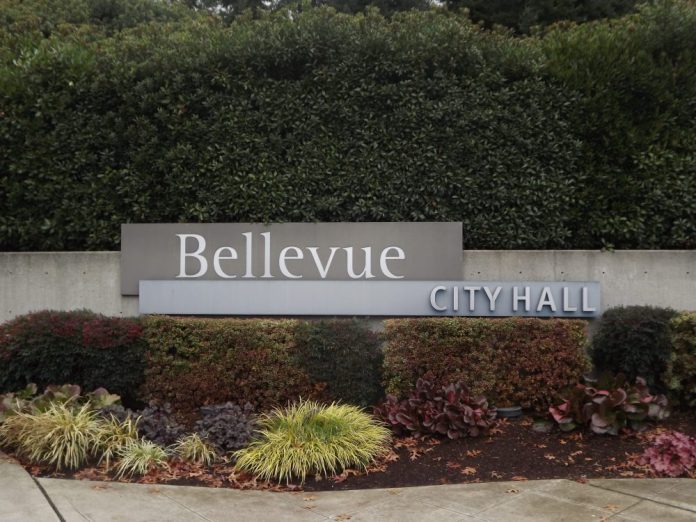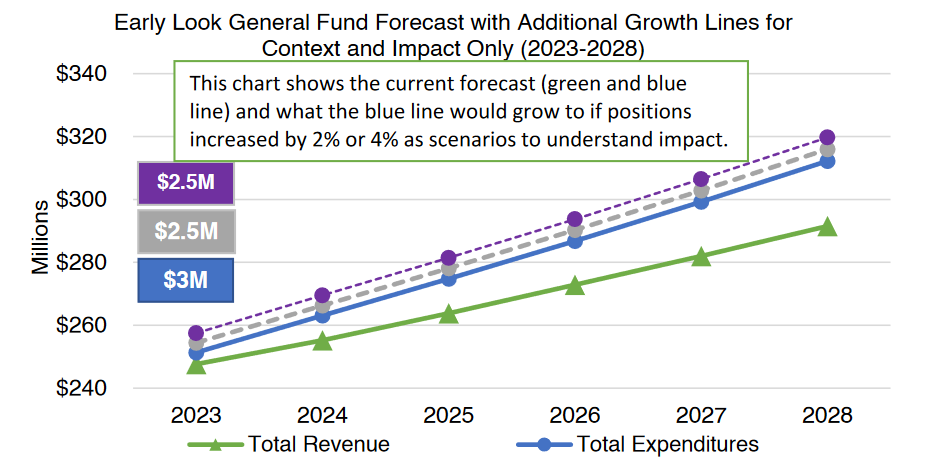King County’s second largest city began its budget season on Monday evening with a foreboding presentation. With lagging property tax revenues, increased demands for services as the city grows, and inflation impacting nearly every economic sector, City staff project a $3 million deficit in Bellevue’s General Fund for 2023. Although that may sound minor for a municipal budget, the annual gap between revenues and expenditures is forecasted to widen to over $20 million by the end of the decade if no action is taken by the city council. Importantly, these gaps are not cumulative — meaning the cumulative deficit in 2028 with no action taken would actually be the gaps in all these years combined, or around $70 million.
In order to keep a balanced budget into the future, the city council will need to either reduce ongoing expenditures (i.e., lower the blue line) or increase ongoing revenues (i.e., raise the green line). The body could choose to temporarily plug the gap with one-time funds (such as Council reserves or American Rescue Plan Act funds), but this only kicks the can down the road. For example, using one-time funds in 2023 would reduce the gap for that year, but since those funds wouldn’t be available going forward, gaps in future years would remain the same.
Complicating the discussions is the uncertain state of affairs around inflation, which staff believe could be anywhere between 4% and 7% when it’s measured later this summer. To provide context, each percentage of inflation is estimated to contribute an additional $1.2 million in annual personnel costs. The projections above are based on an assumption of 5%, so if prices come in over that mark, the gap will widen even further.
With estimates still rough and many details unknown, Councilmembers’ suggestions were varied but remained mostly general. Perhaps the most surprising comments came from noted fiscal conservative Councilmember Conrad Lee, who seemed to express openness for getting big corporations like Amazon to pay their fair share in taxes.
“We’re seeing that Amazon is coming, and other major corporations, and they’re doing very well… they are a part of our city [and we] provide them their ability to grow. They cannot just take the profits and park it. They have to participate in helping the city’s growth in all ways, including our financial situation.”
Councilmember Conrad Lee
A Rosier Outlook for Capital Projects
With a longer planning horizon of seven years, the city’s projections for its 2023-29 Capital Investment Program (CIP) are better than those for the 2023-24 General Fund. After subtracting funds needed for debt servicing, ongoing infrastructure maintenance, and extending already-funded projects through 2029, staff estimate at least $45 million total will be available for new capital improvement projects (such as transportation projects, community centers, and new parks facilities) in 2028 and 2029.
In additional positive news, the City is expecting higher 2021 revenues for its Real Estate Excise Tax (REET) than what were initially forecasted; this will net Bellevue an additional $20 million that can be used for capital projects in transportation or parks. However, the need for capital projects still exceeds the funds available, so staff will use a prioritization framework to select which projects will be financed.
Since the process is still in its early stages, councilmembers’ comments were about this framework itself rather than individual projects that could be funded. Perhaps most significantly, progressive Councilmember Janice Zahn asked that factors like equity and sustainability also be explicitly considered in project prioritization. With staff implementing a new equity lens in this cycle’s budget process, and Mayor Lynne Robinson expressing support for the City evaluating sustainability “in everything it does,” it will be interesting to see if and how these aspects are implemented into capital investment decisions.
Broad Support for a New Parks Levy
To build off of recent work updating the City’s Parks and Open Space System Plan, Council had previously asked for budget discussions specifically focused around parks funding. As The Urbanist author Shaun Kuo noted last year, Bellevue currently has a voter-approved 20-year parks levy (set to expire in 2028) that has funded capital projects at Downtown Park, Surrey Downs Park, and many others. But in response to a question from Mayor Robinson, staff shared that remaining funding from the current levy are set to only fund two additional projects: land acquisition for a park along Lake Sammamish and improvements to Bellevue’s Airfield Park.
Perhaps reflective of widespread support for parks funding in staff’s outreach, city council support for a new levy was shared across the ideological spectrum. After noting how inflation across 20-year agreements leads to reduced purchasing power later in a levy’s life, conservative Councilmember Jennifer Robertson expressed support for bringing a shorter 10-year parks levy to voters later this year, combined with a sunsetting of the current levy.
Some councilmembers cautioned against narrowing the focus of the levy to just parks, given the other funding needs the city is experiencing, but ultimately members were supportive of staff returning with more information on what a levy could look like. If funds could also be used for visionary items like the I-405 Lid Park or the Cross-Cultural Center, a new levy later this year could help facilitate some exciting projects that would make Bellevue an even more impressive place to be.
Chris Randels is the founder and director of Complete Streets Bellevue, an advocacy organization looking to make it easier for people to get around Bellevue without a car. Chris lived in the Lake Hills neighborhood for nearly a decade and cares about reducing emissions and improving safety in the Eastside's largest city.





